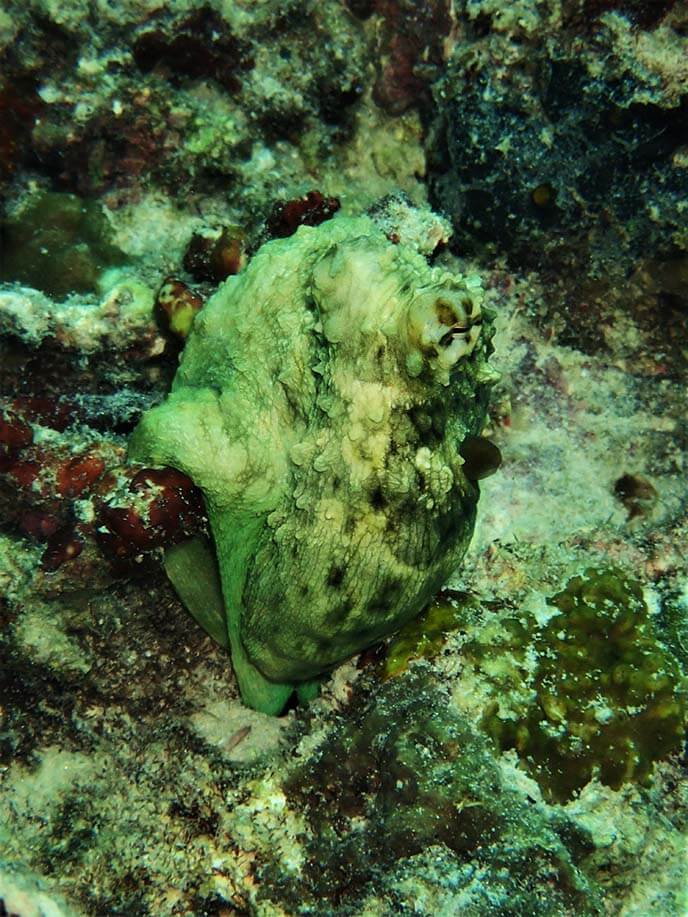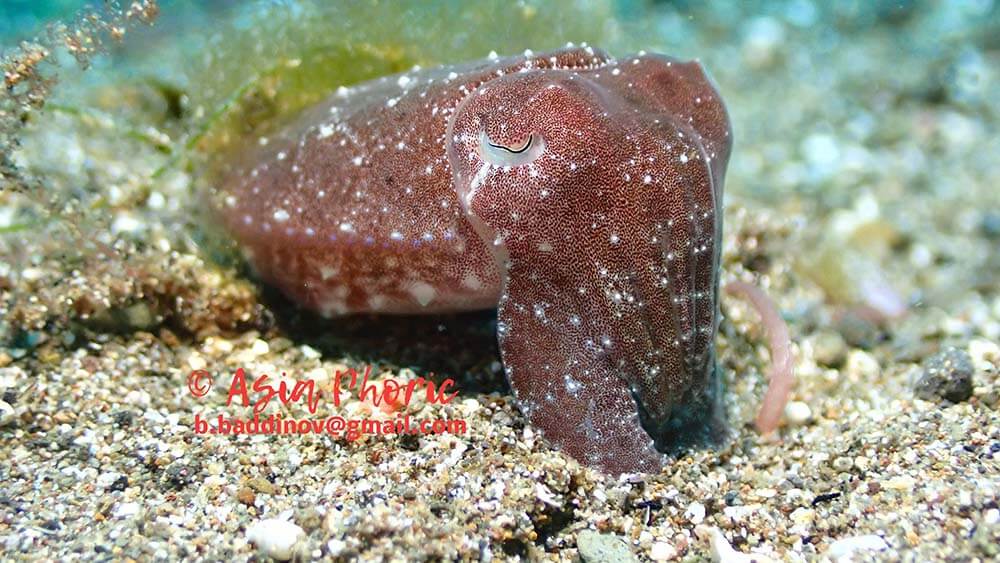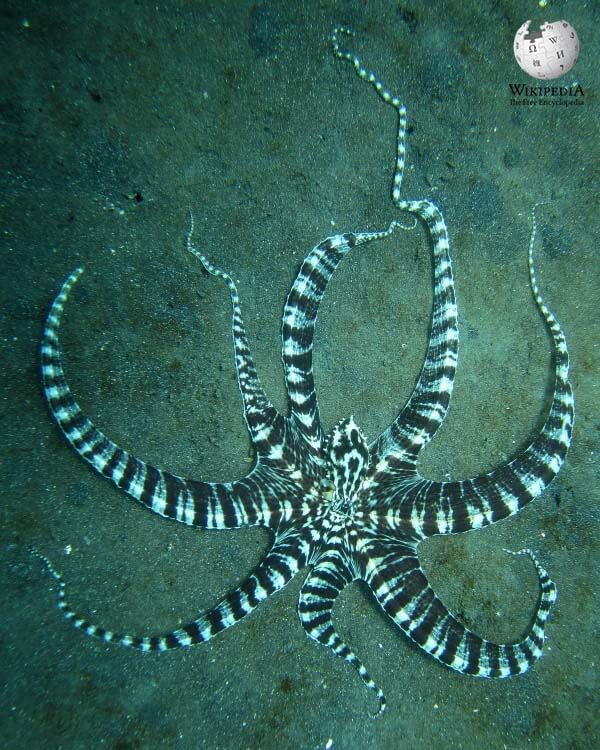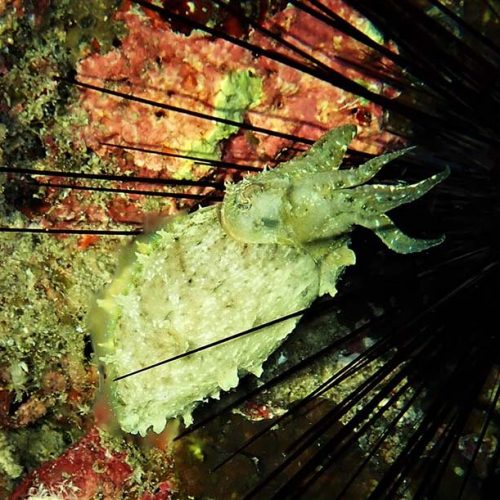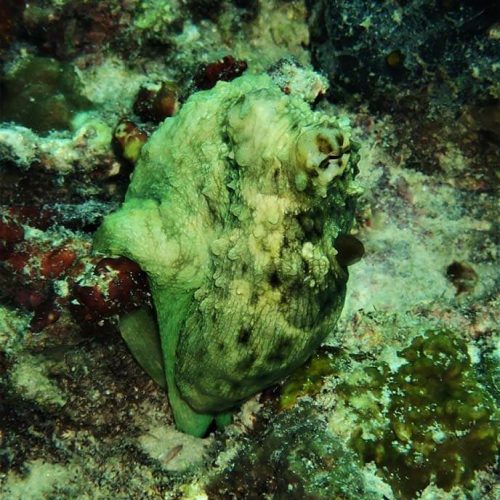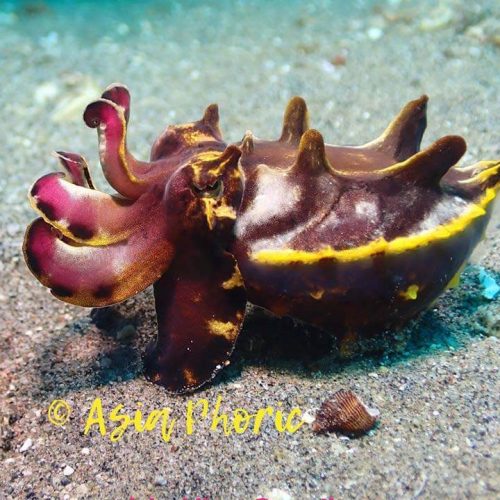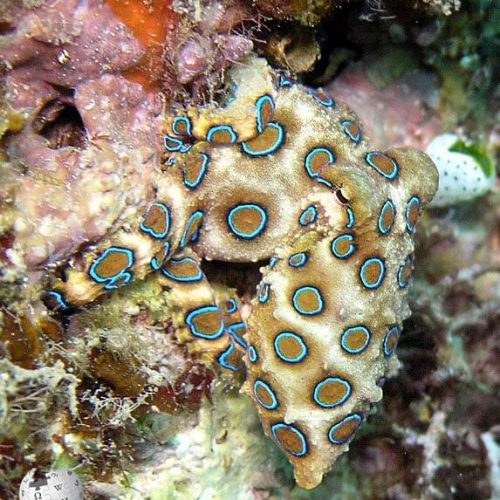Contents
The mimic octopus (Thaumoctopus mimicus) is a species of octopus from the Indo-Pacific region. Like other octopuses, it uses its chromatophores to disguise itself. It is noteworthy for being able to impersonate a wide variety of other marine animals.[2] While many animals mimic either their environment or other animals to avoid predation, the mimic octopus and its close relative the wunderpus are the only ones known to actively imitate several animals in order to elude predators.[3]
Appearance
The mimic octopus is a smaller octopus, growing to a total length of about 60 cm (2 ft), including arms, with a diameter approximately that of a pencil at their widest. Small horns protrude from each eye. The octopus' natural color is light brown/beige, but it usually takes on a more noticeable hue of striped white and brown to scare off predators by imitating poisonous species. According to DNA sequence analysis, the second evolved trait was the simultaneous development of its lengthy arms and its flatfish-like swimming ability. By transfusing these traits together, the octopus transforms to a bold color pattern while swimming like a flatfish when hunting for food or resting.[4]
Habitat and range

The mimic octopus was first discovered off the coast of Sulawesi, Indonesia in 1998 on the bottom of a muddy river mouth.[5][6] It has since been found to inhabit the Indo-Pacific, ranging from the Red Sea and Gulf of Oman in the west to New Caledonia in the east, and Gulf of Thailand and the Philippines in the north to the Great Barrier Reef in south.[1][7][8] Most documented observations are from Indonesia.[7] It is primarily found in areas with sand or silt at depths of less than 15 m (49 ft).[2] It prefers obscuring murky and muddy sea floors to blend in with its natural brown-beige coloring.
Behavior
The mimic octopus uses a jet of water through its funnel to glide over the sand while searching for prey, which mostly consists of small fish, crabs, and worms. It prefers river mouths and estuaries, as opposed to reefs which are usually preferred as shelter by other types of octopus.

Mimic octopuses have been observed mimicking numerous different species of animals, some animals being mimicked more often than others. Among the animals mimicked are lionfish (the octopus holds its arms out radially to mimic the fish's spines), sea snake (hiding 6 of its arms, it holds the remaining 2 parallel to each other),[9] jellyfish (by inflating its mantle and trailing its arms behind it), and zebra sole (holding all 8 arms behind it as it uses its siphon to swim). The octopus' mimicry of flatfish may be its preferred guise; a 2008 study showed that over a period of 5 days, nearly 500 instances of flatfish mimicry were seen by a single individual.[10] Not only does the mimic octopus use its ability to defend from predators, it also uses aggressive mimicry to approach wary prey, for example mimicking a crab as an apparent mate.
The mimic octopus retains the ability to camouflage with its sandy environment. It was also observed to mimic sessile animals such as small sponges, tube worm tubes, or colonial tunicates.[10] While the mimic octopus retains its ability to camouflage with its surroundings while swimming, they are also able to do this even when not swimming. Octopus are typically colorblind, they only have one type of visual pigment, but Mimic octopus have remarkable control over their skin. With them being colorblind, their bodies are quite reflective, which is what allows them to blend in with their surroundings such as; sand, coral, rocks and algae. [11]
The octopus may be able to intelligently use its mimicry based on the situation. For example, a mimic octopus which was being harassed by damselfish mimicked a banded sea snake, a known damselfish predator.[12] The mimic octopus has also been observed in opportunistic mimicry with a jawfish.[13]
Mimic octopus stand out from other octopus species because of their extraordinary ability to mimic and imitate a wide variety of species. Most species that are able to mimic can only mimic a single animal. Whereas, the Mimic octopus can switch between various disguises, 18 different marine animals. They do this not by just changing their color, but also their shape and behavior. While appearing as a typical octopus at rest, this species can undergoes a transformation when engaged in its natural habitat, the Mimic octopus employs a strategy of self-defense by mimicking the appearance of either dangerous or unpalatable species.[14]
Intelligence
Octopus are generally a very highly intelligent species. Their brains are especially large for an invertebrate, their brains contain roughly around 300 million neurons and their arms contain roughly 50 million neurons. Each of their eight arms has its own neural network. This allows them to a have better control, sense of touch, and decision-making abilities. Their brains allow for rapid learning, camouflage, mimicry, memory, vision, and motor control. Mimic octopus being highly intelligent helps them better survive in their environment and adapt. Much like other invertebrates, octopus don't only rely on instinct but rather on experience and learning. Mimicry is considered to be an evolved behavior.[15] Octopus being able to mimic a variety of animals shows that this species may be observing and learning about its environment. This shows how highly intellectual these octopus are.
Some scientists believe that this species might have some sort of consciousness compared to other animals. Some examples of their intellectual capabilities include the ability to open jars by watching humans, using coconut shells as mobile armor, turning off aquarium lights to avoid excessive brightness, and creating mental images, which helps them in order to navigate and hunt down prey in their environments. [6]
Feeding
The mimic octopus can either be classified as a hunter or a forager. It is believed to be a hunter because scientists have observed and recorded the octopus having the ability to stalk prey and hunt down small fish and catch them. More often, however, the mimic octopus can be seen foraging for food. It does this by using a jet of water through its siphon to glide over the sand while searching for prey, and using its slender arms to reach into crevices in coral, as well as holes in the sand, and use its suction cups to grab small crustaceans and eat them. Because the mimic octopus prefers to live in shallow, murky waters, it is believed that its diet consists almost exclusively of small fish and crustaceans. They are believed to be carnivores, and are not known to eat any type of plant or vegetation.[2]
References
- ^ a b c Norman, M.D.; and Hochberg, F.G. (2005). "The 'mimic Octopus' (Thaumoctopus mimicus n. gen. et sp.), a new octopus from the tropical Indo-West Pacific (Cephalopoda: Octopodidae)." Molluscan Research 25: 57–70.
- ^ a b c Maculay, G. (January 6, 2012). "Mimic Octopus Creature Feature - Diving with Mimics". Dive The World - Scuba Diving Vacations - Dive Travel - Diving Holidays - Liveaboards. Retrieved April 21, 2013.
- ^ Harmon, Katherine (February 21, 2013). "Mimic Octopus Makes Home on Great Barrier Reef". Scientific American Blog Network. Retrieved 2023-03-23.
- ^ Baker, Beth (2010). "Unusual Adaptations: Evolution of the Mimic Octopus". BioScience. 60 (11): 962. doi:10.1525/bio.2010.60.11.18. ISSN 0006-3568. JSTOR 10.1525/bio.2010.60.11.18.
- ^ "Mimic Octopuses, Thaumoctopus mimicus". MarineBio. MarineBio Conservation Society. January 14, 2013. Archived from the original on October 25, 2007. Retrieved December 17, 2014.
- ^ a b Norman, Mark D.; Finn, Julian; Tregenza, Tom (2001-09-07). "Dynamic mimicry in an Indo–Malayan octopus". Proceedings of the Royal Society of London. Series B: Biological Sciences. 268 (1478): 1755–1758. doi:10.1098/rspb.2001.1708. ISSN 0962-8452. PMC 1088805. PMID 11522192.
- ^ a b Coker, Darren J. (2013). "Documentation of the mimic octopus Thaumoctopus mimicus in the Great Barrier Reef, Australia." Marine Biodiversity Records 1-2.
- ^ Nabhitabhata, Jaruwat; and Sukhsangchan, Charuay (2007). New Photographic Record of the Mimic Octopus in the Gulf of Thailand. Phuket Mar. Biol. Cent. Res. Bull. 68: 31–34.
- ^ "Mimic Octopuses". Marinebio.org. Archived from the original on 18 July 2017. Retrieved 27 June 2017.
- ^ a b Hanlon, R. T.; Conroy, L.-A.; Forsythe, J. W. (2008). "Mimicry and foraging behaviour of two tropical sand-flat octopus species off North Sulawesi, Indonesia". Biological Journal of the Linnean Society. 93: 23–38. doi:10.1111/j.1095-8312.2007.00948.x.
- ^ Luis, Nahmad-Rohen; H., Qureshi, Yusuf; Misha, Vorobyev (December 2022). "The Colours of Octopus: Using Spectral Data to Measure Octopus Camouflage". Vision. 6 (4). doi:10.3390/vi (inactive 1 May 2025). ISSN 2411-5150. Archived from the original on 2024-12-14.
{{cite journal}}: CS1 maint: DOI inactive as of May 2025 (link) CS1 maint: multiple names: authors list (link) - ^ John Roach (21 September 2001). "Newfound Octopus Impersonates Fish,Snakes". National Geographic. Archived from the original on October 18, 2001.
- ^ Rocha, L. A.; Ross, R.; Kopp, G. (2012-03-01). "Opportunistic mimicry by a Jawfish". Coral Reefs. 31 (1): 285. Bibcode:2012CorRe..31..285R. doi:10.1007/s00338-011-0855-y. ISSN 1432-0975.
- ^ Balyi, Blanka; Fushtey, Krystyna; Marinović, Nela (2024-02-02). "The Mimic Octopus". AIDASCO Reviews. 2 (1): 17–21. doi:10.59783/aire.2024.36. ISSN 2956-0888.
- ^ Balyi, Blanka; Fushtey, Krystyna; Marinović, Nela (2024-02-02). "The Mimic Octopus". AIDASCO Reviews. 2 (1): 17–21. doi:10.59783/aire.2024.36. ISSN 2956-0888.
Further reading
- Butvill, David B (7 October 2005). "The Changeling". Current Science.
- Hearst, M.; Noordeman, J (2012). Unusual creatures: A mostly accurate account of some of the Earth's strangest animals. San Francisco: Chronicle Books: Chronicle Books. ISBN 978-1-4521-0467-6. [children's book]
- PZ Myers (29 November 2004). "Indo-Malayan mimic octopus". Pharyngula. Archived from the original on September 16, 2008.
- Norman, Mark. "Masters of Mimicry". Nature Australia. Vol. 27, no. 6 (Spring 2002 ed.). Australian Museum. Trust. p. 38.
- MDPI and ACS Style Nahmad-Rohen, L.; Qureshi, Y.H.; Vorobyev, M. The Colours of Octopus: Using Spectral Data to Measure Octopus Camouflage. Vision 2022, 6, 59. https://doi.org/10.3390/vision6040059 AMA Style Nahmad-Rohen L, Qureshi YH, Vorobyev M. The Colours of Octopus: Using Spectral Data to Measure Octopus Camouflage. Vision. 2022; 6(4):59. https://doi.org/10.3390/vision6040059 Chicago/Turabian Style
Nahmad-Rohen, Luis, Yusuf H. Qureshi, and Misha Vorobyev. 2022. "The Colours of Octopus: Using Spectral Data to Measure Octopus Camouflage" Vision 6, no. 4: 59. https://doi.org/10.3390/vision6040059 APA Style
Nahmad-Rohen, L., Qureshi, Y. H., & Vorobyev, M. (2022). The Colours of Octopus: Using Spectral Data to Measure Octopus Camouflage. Vision, 6(4), 59. https://doi.org/10.3390/vision6040059 - Adams, Sam S.; Burbeck, Steve (2012), Wang, Pei; Goertzel, Ben (eds.), "Beyond the Octopus: From General Intelligence Toward a Human-Like Mind", Theoretical Foundations of Artificial General Intelligence, Paris: Atlantis Press, pp. 49–65, doi:10.2991/978-94-91216-62-6_4, ISBN 978-94-91216-62-6, retrieved 2025-05-01
- Luis, Nahmad-Rohen,; H., Qureshi, Yusuf; Misha, Vorobyev, (2022-12). "The Colours of Octopus: Using Spectral Data to Measure Octopus Camouflage". Vision. 6 (4). doi:10.3390/vi. ISSN 2411-5150. Archived from the original on 2024-12-14.
- Balyi, Blanka; Fushtey, Krystyna; Marinović, Nela (2024-02-02). "The Mimic Octopus". AIDASCO Reviews. 2 (1): 17–21. doi:10.59783/aire.2024.36. ISSN 2956-0888.

